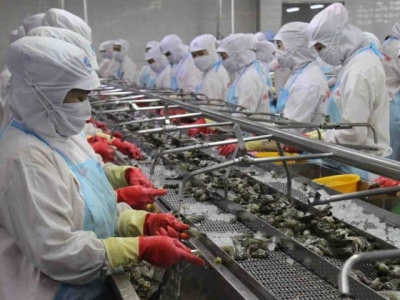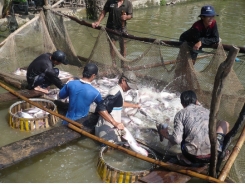Shrimp exports expected to increase in 2018

Exports of shrimp, considered a key export in the fishery sector in 2018, could exceed 2017 figures.
Positive signal
Vietnam’s first seafood shipments in 2018 to Canada, the US and the UK augur a bright outlook for the whole year. The total value of these orders reached US$600,000, with shrimp being the main component.
According to the Vietnam Association of Seafood Exporters and Producers (VASEP), shrimp exports reached US$3.8 billion in 2017, an increase of 21 percent compared to the previous year and just behind the 2014 record of US$3.9 billion.
The positive 2017 shrimp export results were attributed to preferential tariffs in some key markets. For example, Vietnam’s shrimp exports to the EU are subject to the Generalized System of Preferences (GSP), which helps reduce import duties and increase competitiveness of Vietnamese shrimp compared to rivals, such as Thailand and China. The EU tariffs on frozen shrimp (HS Code 030617) and processed frozen shrimp (HS Code 160521) are 4.2 percent and 7 percent, respectively, whereas Thailand and China are not eligible for the EU’s GSP.
India’s shrimp exports to the EU were down because antibiotics were frequently found in its products, and Indian companies faced the risk of bans. This meant European importers were looking for safer shrimp products, such as Vietnamese ones. In 2017, the EU was the largest importer of Vietnamese shrimp, accounting for 22.2 percent of the total value of Vietnamese shrimp exports.
The strong shrimp export growth last year was also due to better control of antibiotic use in breeding the crustacean.
Opportunities
The EU-Vietnam Free Trade Agreement, which is expected to come into effect this year, will help make Vietnamese shrimp more competitive than Thai and Indonesian ones. Specifically, the tax on raw shrimp HS Code 03061100 (chilled green lobster, HOSO black tiger shrimp, frozen DP shrimp, fresh/frozen PD shrimp and frozen whole shrimp) to the EU will be subject to zero taxation from the current level of 12.5 percent. The tax on shrimp HS Code 03061710 (frozen PD black tiger shrimp, frozen HOSO whole black tiger shrimp, frozen shrimp headed and shell-on, frozen/fresh black tiger shrimp, frozen black tiger shrimp meat, frozen/fresh HLSO black tiger shrimp, frozen/fresh IQF black tiger shrimp and frozen white-leg shrimp meat) will be zeroed out from the current level of 20 percent.
In addition to the EU, China is expected to become the second largest market for Vietnamese shrimp in 2018. China has high demand for seafood and its domestic output has shrunk due to diseases and unfavorable weather. In addition, since December, China has cut the import tariff on frozen shrimp from five percent to two percent. These factors would boost Vietnam’s shrimp exports to China.
The southern province of Bac Lieu should focus on super intensive, high-tech shrimp farming to become the nation’s shrimp hub. The province should apply the climate change model in shrimp farming to take advantage of the weather and market demand. To achieve this goal, the province must sustain clean production with high-quality products and new technology. In addition, local authorities should improve infrastructure and logistics to create favorable conditions for shrimp farming and processing.
VASEP has adjusted the shrimp export target from US$8.5 billion to US$9 billion for 2018. VASEP forecasts that shrimp exports would rise strongly this year especially to the EU, China, Japan, and the Republic of Korea.
Related news
Tools

Phối trộn thức ăn chăn nuôi

Pha dung dịch thủy canh

Định mức cho tôm ăn

Phối trộn phân bón NPK

Xác định tỷ lệ tôm sống

Chuyển đổi đơn vị phân bón

Xác định công suất sục khí

Chuyển đổi đơn vị tôm

Tính diện tích nhà kính

Tính thể tích ao



 The export of catfish: too many difficulties
The export of catfish: too many difficulties  Ministry urges US to study Vietnamese tra fish…
Ministry urges US to study Vietnamese tra fish…